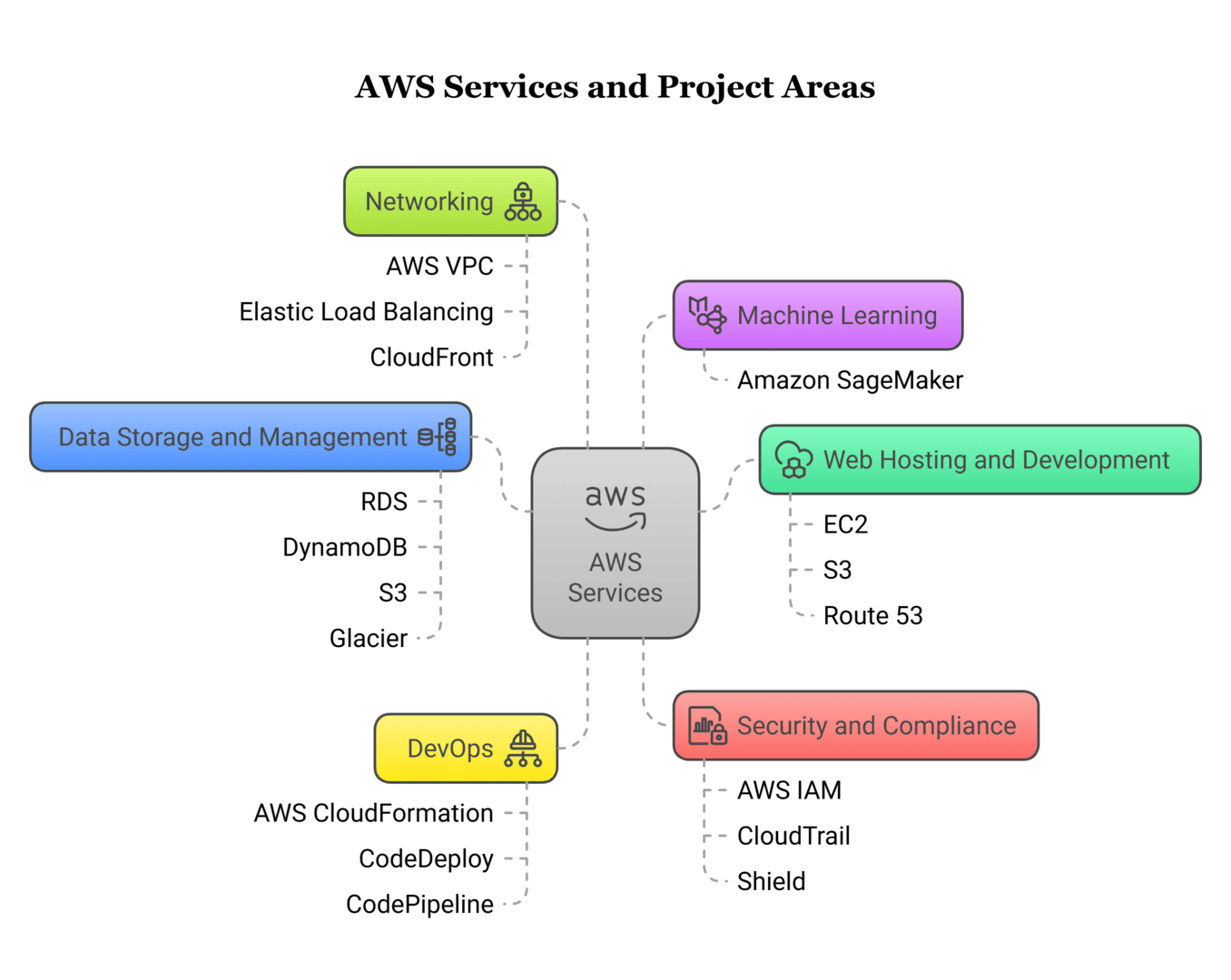Top 10 Ultimate AWS Projects & Ideas [2025]
Table of Contents
![Top-10-Ultimate-AWS-Projects-&-Ideas-[2025]](https://jaro-website.s3.ap-south-1.amazonaws.com/2024/09/Top-10-Ultimate-AWS-Projects-Ideas-2025-1.webp)
- jaro Education
- 4, September 2024
- 3:00 pm
AWS enjoys the largest market share, with 31 percent of the global market. To get any tech job, having an AWS certification or working on an AWS project is obligatory. Starting with data engineers and ending with cloud architects, you may find a good job as a specialist in AWS.
But it is not only a matter of theoretical knowledge. Pragmatic projects assist in realizing the real capabilities of AWS and utilizing it. A lot of such projects, especially the ones that employ Artificial Intelligence and machine learning, have the potential to either augment your talents considerably or empower you to become a top-notch expert in cloud computing.
Are you willing to start your stint in AWS cloud projects and are searching for AWS project ideas and topics that could help you in practical learning? Then you are sitting in the right place.
Here in this blog, we shall explore 10 more of such AWS project ideas, which are ideal projects in AWS for a beginner.
AWS Services List: AWS Project Areas
The cloud service provider Amazon Web Services (AWS) owns 31% of the worldwide market share and is the present leader in this area. This position implies that an AWS certification is necessary for many tech roles, including a data engineer or cloud architect. However, theoretical knowledge alone is insufficient; hands-on projects must be undertaken to understand and exploit AWS cloud projects capabilities fully.

- Web Hosting and Development: Amazon provides an AWS real-time projects examples services list that includes EC2, S3, and Route 53 to deploy websites and web applications.
- Machine learning: AWS project ideas, like Amazon SageMaker, help implement ML models in an organisation’s operations.
- DevOps: Automating infrastructure deployment and management with services like AWS CloudFormation, CodeDeploy, and CodePipeline.
- Data Storage and Management: Data needs to be stored properly to ensure efficient operations. Using AWS databases, like RDS and DynamoDB, as well as storage solutions, like S3 and Glacier, helps improve data warehousing and management.
- Security and Compliance: One of the best aspects of the AWS services list is the AWS Identity and Access Management (IAM) along with CloudTrail and Shield. They are used to implement security measures and protect the stored data on the cloud.
- Networking: Setting up secure and scalable networks using AWS VPC, Elastic Load Balancing, and CloudFront.
Why AWS Projects for Beginners Are Beneficial
- Learning Opportunities: AWS projects for beginners provide practical experience and a chance to put theory into practice with real-world scenarios.
- Portfolio Building: A complete AWS project makes for an excellent addition to a beginner’s portfolio. It showcases your contribution to the project and the skills and expertise needed to accomplish it.
- Industry-Relevant Skills: Working on AWS project ideas helps learners acquire skills that are in high demand in the tech industry, such as cloud computing, DevOps, and machine learning.
- Easily Accessible Learning: There are AWS projects that are low-cost and easily accessible, making it easy for beginners to learn and experiment without any major financial investment.
In summary, AWS projects for beginners are a fantastic way to advance in your career and also open up the space for cross-career opportunities in machine learning, data science, DevOps, and cloud engineering.
AWS Projects for Beginners: AWS Projects and Ideas [2025]
Here is a compilation of eight AWS projects for beginners with a focus on different areas of expertise:
1. Website Hosting
Using Amazon S3, it is extremely lucrative and accessible to deploy a static website.
Solution: Start by creating a static website mockup, for example, a personal portfolio for your photography. You can easily host it on Amazon S3:
Step 1: Set up an S3 bucket to hold all the different pages of your portfolio website.
Step 2: Configure the S3 bucket and grant public access.
Step 3: Enable website hosting.
Moreover, you can also use different aspects of the AWS real-time projects examples services list, like Amazon Route 53, to manage the Domain Name System and create a custom website link for your portfolio. This project introduces you to AWS S3, static website hosting, and DNS management.
2. DevOps
Working on the CI/CD pipeline, also known as Continuous Integration/Continuous Deployment, is one of the best ways to understand the nuances of the DevOps section in the AWS services list. An AWD project idea for beginners is to automate code deployment using the AWS CodePipeline.
Step 1: Set up the CI/CD pipeline. The procedure automates the building, testing, and deployment process for a web application.
Step 2: Put it on AWS CodeCommit for version control operations.
Step 3: Work on CodeBuild for compiling and testing your code.
Step 4: Use CodeDeploy to put it on Amazon EC2 or AWS Lambda.
This project helps you understand the basics of version control, continuous integration, and automated deployments.
3. Machine Learning
An effortless AWS project for beginners is to build and deploy an ML model using Amazon SageMaker. For example, you could train a simple ML model like a binary classifier using any dataset.
Step 1: Data Preparation
Upload your dataset to Amazon S3 and use SageMaker to clean, transform, and split the data for training and testing.
Step 2: Model Training
Use SageMaker’s built-in algorithms or bring your own model to train a binary classifier. You can customize hyperparameters for better performance.
Step 3: Model Deployment
Deploy the trained model to a SageMaker endpoint to enable real-time predictions through a REST API.
Step 4: Evaluation & Monitoring
Test the model using new data to evaluate its accuracy. Use Amazon CloudWatch to monitor performance and retrain if needed.
This is the perfect entry point to using ML within the AWS real-time projects examples ecosystem because it provides profound insights into data preparation and model deployment.
4. Data Warehousing
An intriguing AWS project for beginners is to set up a warehouse for the management and analysis of large datasets with Amazon Redshift
Step 1: Open Amazon Redshift and create a data warehouse inside it with data from various sources within the AWS ecosystem.
Step 2: Use SQL to run queries and gather insights to analyse the large datasets.
This project provides insights into analysing large datasets with the space to scale. It covers data storage and query optimisation.
5. Web Applications
You can use AWS Lambda, API Gateway, and DynamoDB in the AWS services list to develop a serverless web application.
Step 1: Build a simple web application using the AWS services list.
Step 2: Use the Amazon S3 services to host the frontend of the web application while the back end is handled by Lambda and API Gateway.
This project provides opportunities for a breakthrough in the serverless applications space, where you can deploy and scale applications without managing any servers.
6. Secure Access Management
With this AWS project for beginners, you can implement role-based access control for a web application.
Step 1: AWS IAM (Identity and Access Management) is used to create roles with specific permissions to access the AWS system.
Step 2: Set up policies for different user groups (e.g., admins, developers) and assign appropriate permissions.
This AWS project for beginners helps with understanding the best security practices, like managing user access and setting up multi-factor authentication.
7. Scalable Network Architecture
With this AWS project for beginners, you can implement role-based access control for a web application.
Step 1: AWS IAM (Identity and Access Management) is used to create roles with specific permissions to access the AWS system.
Step 2: Set up policies for different user groups (e.g., admins, developers) and assign appropriate permissions.
This AWS project for beginners helps with understanding the best security practices like managing user access and setting up multi-factor authentication.
8. Cloud Resource Management
One great way to learn about cloud infrastructure is through the AWS CloudFormation. For example, you could automate the deployment of the cloud infrastructure with it.
One great way to learn about cloud infrastructure is by using AWS CloudFormation. For example, you can automate the deployment of your entire cloud infrastructure using a single template.
Step 1: Define the Infrastructure
Use AWS CloudFormation to create a stack that includes resources like EC2 instances, RDS databases, and S3 buckets—all managed through a single YAML or JSON template.
Step 2: Deploy and Manage
Deploy the stack and monitor it through the CloudFormation console. Update, scale, or delete resources automatically while maintaining infrastructure consistency.
This project helps you understand Infrastructure as Code (IaC) principles, automate provisioning, and manage resources in a consistent, repeatable manner.
This project allows you to learn Infrastructure as Code (IaC) principles, automate resource provisioning, and manage infrastructure in a consistent, repeatable manner.
9. Launching SQL Server Database on Amazon RDS
The Amazon RDS for SQL Server event walks attendees through a step-by-step process of using Amazon RDS. You’ll create a DB instance and learn essential concepts about automotive backups, security, scaling, optimizing, and monitoring of your DB instance.
10. Serverless Image Processing
This is a quick intro to a project that employs a serverless architecture to create an image processing workflow using AWS Step Functions, AWS Lambda, Amazon DynamoDB, and Amazon SNS.
With AWS Step Functions to orchestrate the many services involved, you will be able to orchestrate and automate complex workflows—a must-have skill for modern cloud-based solutions.
The AWS services used in this project:
- Amazon Rekognition detects if there is a face within an uploaded image.
- AWS CloudFormation quickly templates the basic resources for addressing the project needs.
- AWS Step Functions orchestrate the workflow.
- AWS Lambda invokes Rekognition.
- Amazon DynamoDB stores image metadata.
- Amazon Simple Notification Service (SNS).
- Amazon EventBridge triggers the state machine to run upon uploading a new image.
Final Thoughts
There are many ways to undertake AWS projects for beginners. It is a vastly accessible ecosystem where learning is encouraged through trial and error. There are also several certifications, workshops, and webinars where you can meet like-minded beginners and skyrocket your career prospects in the AWS space.
Frequently Asked Questions
AWS projects are hands-on implementations using Amazon Web Services to build, deploy, and manage applications in the cloud. These projects can range from hosting a static website to building AI-driven, serverless solutions. They help learners gain practical experience with cloud computing.
Working on AWS projects improves your practical knowledge, prepares you for AWS certifications, strengthens your resume, and helps you build a portfolio that showcases real-world cloud skills to potential employers.
Beginners can start with simple projects like:
- Hosting a static website on Amazon S3
- Launching a virtual server using EC2
- Creating a Lambda function
- Setting up a basic DynamoDB table
These projects teach core AWS concepts in an easy-to-understand way.
Yes! AWS offers a Free Tier that includes limited usage of services like EC2, S3, Lambda, and RDS. You can build small-scale projects without incurring costs as long as you stay within the free usage limits.
Employers look for projects that demonstrate real-world skills. Some strong resume-worthy projects include:
- CI/CD pipeline with AWS CodePipeline
- Scalable web app with Auto Scaling and Load Balancer
- Real-time data analysis using Kinesis and Lambda
- Serverless chatbot using AWS Lex










